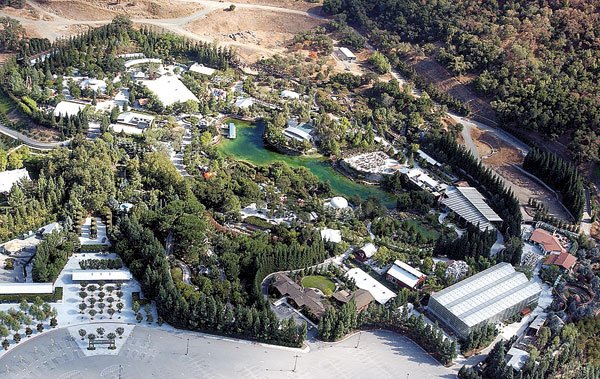Residents applauded after Council members rallied together
Tuesday night to unanimously approve the city’s $14 million
purchase of GIlroy Gardens.
Council members rallied together Tuesday night to unanimously approve the city’s $14 million purchase of Gilroy Gardens.
At the behest of Councilman Bob Dillon, the body agreed to scuttle a controversial $1 per year lease and instead charge the park’s non-profit board of directors 10 percent of its positive earnings. The city plans to buy the 536-acre horticultural park and all of its rides and buildings and then lease the whole package back to the board.
Finally. Great, said Board President Bob Kraemer as applause faded from the council chambers Tuesday night.
“We feel this compromise is good for both parties, and we’re very happy about the 7-0 vote,” Kraemer said before braving the rain on his way home. “We’ve started off on a good foot.”
The council’s united decision also scrapped Mayor Al Pinheiro’s idea from the Jan. 14 study session to require a super majority on the council for it to dissolve the park. This would require at least a 5-2 vote, but the mayor said Tuesday night that it was just an idea the media had misinterpreted as a “shotgun approach.”
“Since when can’t someone on this council bring an idea to the table?…That super majority idea came out of care. We have got to get away from this ‘Us versus Them’ approach,” Pinheiro told his colleagues in partial reference to Councilman Perry Woodward. At the Jan. 14 meeting, Woodward said he would vote against the entire purchase agreement if it included a super majority clause because he said it violated his sense of democratic principles.
All council members seemed to agree Tuesday night, however, that acquiring the park is a sound long-term decision. Councilmen Dion Bracco and Peter Arellano pointed out that the park employs many young residents. Plus any money it has left over after a lease payment would go right back into the park’s maintenance and improvement, they said, essentially bolstering the city’s newest asset.
Over the past six years, the park has earned about $258,000 annually after subtracting its operating expenses from its operating revenue and then adding other revenue such as interest on investments, according to Assistant City Administrator Anna Jatczak. This translates into an annual lease payment of about $25,800.
This is a far cry from the $1.3 million the park has paid to bondholders each year. The park earned enough to cover its annual debt payments to bondholders only once in 2005 when it ended up with nearly $1.9 million. This left plenty of funds for the board to cover its $800,000 payment in November and its $500,00 payment in May. The rest of the years the park has had to rely on reserves to cover its two annual payments.
Bracco succeeded Pinheiro as the council’s representative on the park’s board, members of which expressed concern to the council in recent weeks that the park might not be able to survive after this year’s first payment to bondholders in March.
Now that does not matter, though, and when it comes to dissolving the park, the council will have the power to do so whenever it wants -– and for whatever reason – with a simple majority. If the park fails on its own, though, it would naturally fall into city hands without a council vote. Either way, the city would need to find another tenant or use for the land, and council members have said they have not yet fleshed out these hypothetical situations.
“There are still some things I don’t like in here, but as a whole, I’ll have to agree with my colleagues that this is a great opportunity,” Councilman Craig Gartman said.
The new lease agreement and the subtraction of the super majority requirement helped persuade Councilmen Woodward, Dillon and Gartman to approve Tuesday night’s purchase. The three voted against the $1 per year lease term and the super majority requirement Jan. 14 in two separate non-binding 4-3 votes. Councilwoman Cat Tucker was the swing vote on both.
Now the city will purchase the park by taking out a 20-year loan for about $14 million. The figure represents how much all of the park’s outstanding bonds will be worth in November 2010, when they are up for sale, plus ongoing consulting and legal fees.
For the next week or so, city staff and contractors will continue conducting environmental reports on the park and surveying its boundaries. So far no red flags have emerged, according to Jatczak, and after the successful completion of all inspections, the city will also require the park to continue its $5 million umbrella insurance coverage and list the city as additional insured. The city will beef up its own insurance policy with another $40,000 to $48,000 in premiums per year that Gilroy Gardens will assume, though this figure is expected to be less, Jatczak said.














